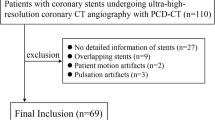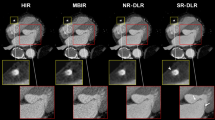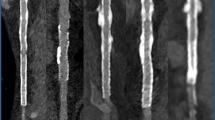Abstract
Computed tomography angiography (CTA) is one of the most common vascular imaging modalities. However, for clinical use, it still requires laborious manual analysis. This study demonstrates the feasibility of a fully automated technology for the accurate detection and identification of several anatomical reference points (landmarks), commonly used in intravascular imaging. This technology uses two different approaches, specially designed for the detection of aortic root and supra-aortic and visceral branches. In order to adjust the parameters of the developed algorithms, a total of 33 computed tomography scans with different types of pathologies were selected. Furthermore, a total of 30 independently selected computed tomography scans were used to assess their performance. Accuracy was evaluated by comparing the locations of reference points manually marked by human experts with those that were automatically detected. For supra-aortic and visceral branches detection, average values of 91.8 % for recall and 98.8 % for precision were obtained. For aortic root detection, the average difference between the positions marked by the experts and those detected by the computer was 5.7 ± 7.3 mm. Finally, diameters and lengths of the aorta were measured at different locations related to the extracted landmarks. Those measurements agreed with the values reported by the literature.

Schematic description of the proposed algorithm. The input includes an already segmented aorta (left), there are two main sub-processes related to the detection of branches and roots (center), and the output includes the segmented original aorta with the branches and the detected landmarks superimposed (right).















Similar content being viewed by others
References
Quantitative Imaging Biomarkers Alliance. https://www.rsna.org/en/research/quantitative-imaging-biomarkers-alliance. Accessed: 2019 05 30
Alemán-Flores M, Santana-Cedrés D, Alvarez L, et al. (2018) Segmentation of the aorta using active contours with histogram-based descriptors. In: Intravascular imaging and computer assisted stenting and large-scale annotation of biomedical data and expert label synthesis: 7th Joint international workshop, CVII-STENT 2018 and third international workshop, LABELS 2018, LNCS, vol 11043. Springer, pp 28–35
Alvarez L, González E, Esclarín J, et al. (2017) Robust detection of circles in the vessel contours and application to local probability density estimation. In: Intravascular imaging and computer assisted stenting and large-scale annotation of biomedical data and expert label synthesis: 6th joint international workshop, CVII-STENT 2017 and second international workshop, LABELS 2017, LNCS, vol 10552. Springer, pp 3–11
Authors/Task Force members, Erbel R, Aboyans V, et al. (2014) 2014 ESC guidelines on the diagnosis and treatment of aortic diseases: Document covering acute and chronic aortic diseases of the thoracic and abdominal aorta of the adult. The task force for the diagnosis and treatment of aortic diseases of the European society of cardiology (ESC). Eur Heart J 35(41):2873–2926
Chaikof EL, Dalman RL, Eskandari MK, et al. (2018) The society for vascular surgery practice guidelines on the care of patients with an abdominal aortic aneurysm. Journal of Vascular Surgery 67(1):2–77e2
Cleemann L, Mortensen KH, Holm K, et al. (2010) Aortic dimensions in girls and young women with turner syndrome: a magnetic resonance imaging study. Pediatr Cardiol 31(4):497–504
Darling RC, Messina C, Brewster D, et al. (1977) Autopsy study of unoperated abdominal aortic aneurysms. The case for early resection. Circulation 56(3 Suppl):161–164
Elattar M, Wiegerinck E, van Kesteren F, et al. (2016) Automatic aortic root landmark detection in CTA images for preprocedural planning of transcatheter aortic valve implantation. Int J Cardiovasc Imaging 32 (3):501–511
Elefteriades JA, Farkas EA (2010) Thoracic aortic aneurysm: Clinically pertinent controversies and uncertainties. J Am Coll Cardiol 55(9):841–857
Entezari P, Kino A, Honarmand A, et al. (2013) Analysis of the thoracic aorta using a semi-automated post processing tool. Eur J Radiol 82(9):1558–1564
Flohr TG, Schaller S, Stierstorfer K, et al. (2005) Multi–detector row CT systems and image-reconstruction techniques. Radiology 235(3):756–773
Hager A, Kaemmerer H, Rapp-Bernhardt U, et al. (2002) Diameters of the thoracic aorta throughout life as measured with helical computed tomography. J Thorac Cardiovasc Surg 123(6):1060–1066
Hiratzka LF, Bakris GL, Beckman JA, et al. (2010) 2010 ACCF / AHA / AATS / ACR / ASA / SCA / SCAI / SIR / STS / SVM guidelines for the diagnosis and management of patients with thoracic aortic disease. J Am Coll Cardiol 55(14):e27–e129
Kanitsar A, Fleischmann D, Wegenkittl R, et al. (2002) CPR – curved planar reformation. In: In Visualization’02. IEEE, pp 37–44
Kikinis R, Pieper SD, Vosburgh KG (2014) 3D Slicer: a platform for subject-specific image analysis, visualization, and clinical support. Springer, New York, pp 277–289
Kitasaka T, Egusa T, Oda M (2010) A method for nomenclature of abdominal arteries extracted from. 3d abdominal CT images based on optimizing combinations of candidate anatomical names. Int J Comput Assist Radiol Surg 5:S45–S49
Kurugol S, Come CE, Diaz AA, et al. (2015) Automated quantitative 3d analysis of aorta size, morphology, and mural calcification distributions. Med Phys 42(9):5467–5478
Laurent S, Cockcroft J, Van Bortel L, et al. (2006) Expert consensus document on arterial stiffness: methodological issues and clinical applications. Eur Heart J 27(21):2588–2605
Macía I, Graña M, Paloc C (2012) Knowledge management in image-based analysis of blood vessel structures. Knowl Inf Syst 30(2):457–491
McComb BL, Munden RF, Duan F, et al. (2016) Normative reference values of thoracic aortic diameter in american college of radiology imaging network (ACRIN 6654) arm of national lung screening trial. Clin Imaging 40(5):936–943
Oda M, Hoang BH, Kitasaka T, et al. (2012) Automated anatomical labeling method for abdominal arteries extracted from 3D abdominal CT images. In: Proceedings Volume 8314, Medical Imaging 2012: image processing, vol 8314
O’Rourke MF, Staessen JA, Vlachopoulos C, et al. (2002) Clinical applications of arterial stiffness; definitions and reference values. Am J Hypertens 15(5):426–444
Queirós S, Papachristidis A, Barbosa D, et al. (2016) Aortic valve tract segmentation from 3d-TEE using shape-based b-spline explicit active surfaces. IEEE Trans Med Imaging 35(9):2015–2025
Rajiah P, Schoenhagen P (2013) The role of computed tomography in pre-procedural planning of cardiovascular surgery and intervention. Insights into Imaging 4(5):671–689
Redheuil A, Yu WC, Mousseaux E, et al. (2011) Age-related changes in aortic arch geometry: Relationship with proximal aortic function and left ventricular mass and remodeling. J Am Coll Cardiol 58(12):1262–1270
Rousseau H, Chabbert V, Maracher M, et al. (2009) The importance of imaging assessment before endovascular repair of thoracic aorta. Eur J Vasc Endovasc Surg 38(4):408–421
Sugawara J, Hayashi K, Yokoi T, et al. (2008) Age-associated elongation of the ascending aorta in adults. J Am Coll Cardiol Img 1(6):739–748
Tahoces PG, Alvarez L, González E, et al. (2019) Automatic estimation of the aortic lumen geometry by ellipse tracking. Int J Comput Assist Radiol Surg 14(2):345–355
Turkbey EB, Jain A, Johnson C, et al. (2014) Determinants and normal values of ascending aortic diameter by age, gender, and race/ethnicity in the multi-ethnic study of atherosclerosis (MESA). J Magn Reson Imaging 39 (2):360–368
Wolak A, Gransar H, Thomson LE, et al. (2008) Aortic size assessment by noncontrast cardiac computed tomography: Normal limits by age, gender, and body surface area. J Am Coll Cardiol Img 1(2):200–209
Acknowledgments
This research has partially been supported by the MINECO projects references TIN2016-76373-P (AEI/FEDER, UE) and MTM2016-75339-P (AEI/FEDER, UE) (Ministerio de Economía y Competitividad, Spain).
Author information
Authors and Affiliations
Corresponding author
Ethics declarations
Conflict of interest
The authors declare that they have no conflict of interest.
Ethical approval
All procedures performed in studies involving human participants were in accordance with the ethical standards of the institutional and/or national research committee and with the 1964 Helsinki Declaration and its later amendments or comparable ethical standards. For this type of study, formal consent is not required.
Additional information
Publisher’s note
Springer Nature remains neutral with regard to jurisdictional claims in published maps and institutional affiliations.
Rights and permissions
About this article
Cite this article
Tahoces, P.G., Santana-Cedrés, D., Alvarez, L. et al. Automatic detection of anatomical landmarks of the aorta in CTA images. Med Biol Eng Comput 58, 903–919 (2020). https://doi.org/10.1007/s11517-019-02110-x
Received:
Accepted:
Published:
Issue Date:
DOI: https://doi.org/10.1007/s11517-019-02110-x




